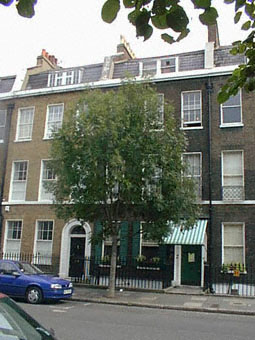|
|

Dickens' House 48 Doughty Street, WC1
 The elegant four-storey house which was home to Charles Dickens and his wife Catherine in the early years of their marriage indicated a step up in the world for the author, who until 1837 had only been able to afford the lease on a cramped apartment in Furnival's Inn. Thanks to the success of Pickwick Papers, though, Dickens was suddenly able to pay the £80 per year it took to rent the property. At that time, Doughty Street was a private road with gates at each end as well as its own porters, so Dickens must have felt that he had really arrived when he took up residence. The elegant four-storey house which was home to Charles Dickens and his wife Catherine in the early years of their marriage indicated a step up in the world for the author, who until 1837 had only been able to afford the lease on a cramped apartment in Furnival's Inn. Thanks to the success of Pickwick Papers, though, Dickens was suddenly able to pay the £80 per year it took to rent the property. At that time, Doughty Street was a private road with gates at each end as well as its own porters, so Dickens must have felt that he had really arrived when he took up residence.
Although Dickens only spent two years in this house, it was the scene of some of his happiest and saddest moments. A mine of creativity, Dickens managed to write the last chapters of Pickwick Papers here and went on to produce Oliver Twist and Nicholas Nickleby. Just over a month after moving into Doughty Street, though, the author's prolific output was halted by the death of his beloved sister-in-law, Mary Hogarth. Dickens was so shattered by the experience that the publication of both Pickwick and Oliver Twist had to be temporarily halted.
The last surviving London home of the author, 48, Doughty Street was saved from demolition in 1923 by the Dickens Fellowship. The society has since lovingly restored the building, as far as possible reconstructing the rooms as Dickens might have known them. Inside is a fascinating collection of memorabilia including many of the author's personal belongings. Alongside famous items such as his desk and chair are quills which he wrote with, the pottery monkey he insisted was always in place before he started work and many more possessions ranging from the quirky to the mundane.
Dickens was, of course, universally acclaimed as an author in his own lifetime and most of the exhibits in this fine collection represent the trappings of a man who achieved status and wealth. Despite this, it is clear from his writing that there was something in the private man which never escaped the terrors of the past. The house in Doughty Street now contains two of the most poignant reminders of that time: the tiny wooden window from the attic room Dickens occupied when his parents moved to London from Chatham in 1823 and a grille from the Marshalsea prison, where his father was imprisoned for debt just a year later.
* As well as being the headquarters of the Dickens Fellowship, 48, Doughty Street contains the Dickens Library, a comprehensive collection of books and other rare items. There is also an unique collection of manuscripts and an extensive photographic collection. Access to these archives are subject to permission from the Curator and researchers should apply for an appointment.

Copyright © Jan Collie 2002
Published by permission of the author.
All rights reserved. No reproduction, copy or transmission of this publication may be made without written permission. |
|